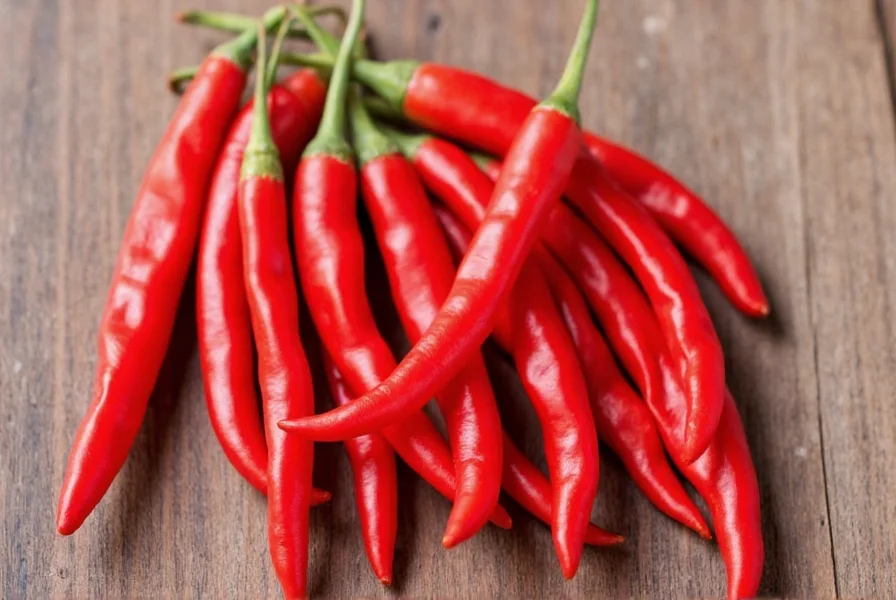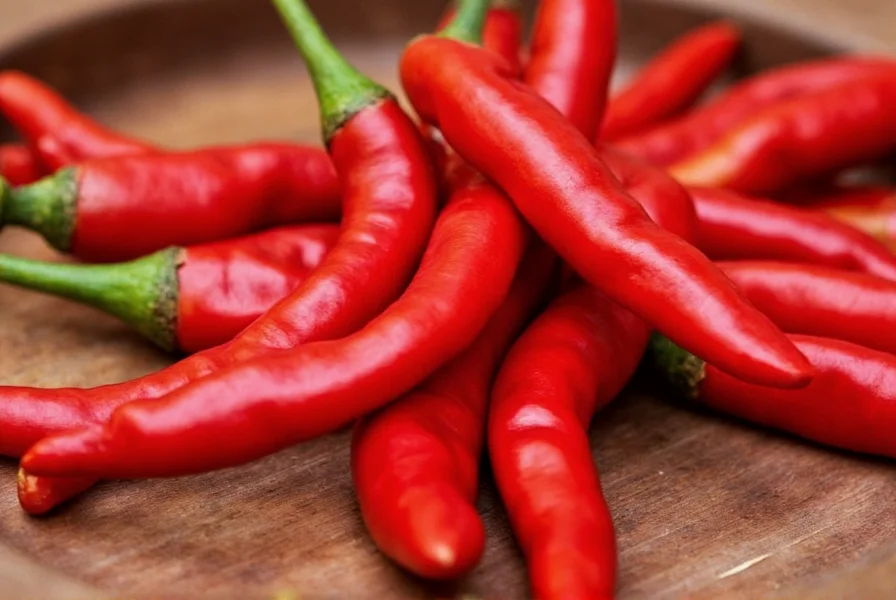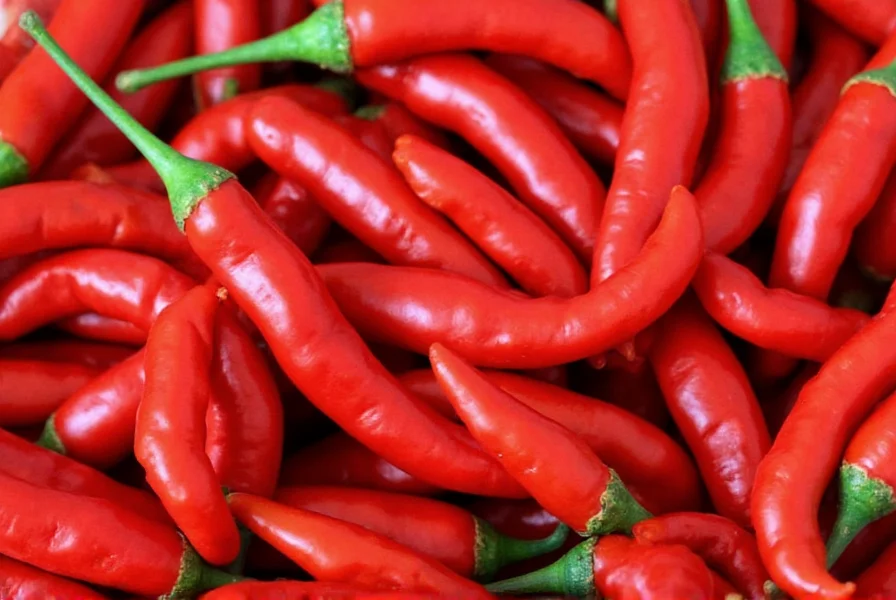When you reach for that vibrant red spice in your kitchen, you're handling one of nature's most potent culinary and medicinal ingredients. Red cayenne pepper isn't just about heat—it's a nutritional powerhouse with scientifically supported benefits that extend far beyond its fiery reputation. This slender, pointed chili delivers a distinctive sharp, pungent flavor that enhances dishes while potentially boosting metabolism, reducing inflammation, and supporting cardiovascular health.
Botanical Profile and Characteristics
Scientifically classified as Capsicum annuum var. annuum, red cayenne pepper belongs to the nightshade family (Solanaceae). Unlike bell peppers, cayenne varieties develop significant heat as they mature from green to their characteristic bright red color. The most common commercial varieties measure between 30,000-50,000 Scoville Heat Units (SHU), placing them significantly hotter than jalapeños (2,500-8,000 SHU) but milder than habaneros (100,000-350,000 SHU).
What gives cayenne its signature heat is capsaicin, concentrated primarily in the pepper's placental tissue (the white ribs inside). This compound triggers thermoreceptors in your mouth, creating the burning sensation we associate with spicy foods. Interestingly, birds—which help disperse pepper seeds—don't feel this heat due to different receptor biology.

Nutritional Composition and Bioactive Compounds
Red cayenne pepper packs impressive nutritional density in minimal volume. Just one teaspoon (2 grams) of cayenne powder contains:
| Nutrient | Amount per Teaspoon | % Daily Value |
|---|---|---|
| Calories | 6 | 0% |
| Vitamin A | 44% DV | Excellent source |
| Vitamin E | 5% DV | Good source |
| Vitamin C | 3% DV | Moderate source |
| Vitamin B6 | 3% DV | Moderate source |
| Manganese | 2% DV | Trace mineral |
The star compound is capsaicin (8-methyl-N-vanillyl-6-nonenamide), which typically constitutes 0.1-1.0% of dried cayenne pepper by weight. Additional beneficial compounds include:
- Carotenoids (beta-carotene, capsanthin) - responsible for red color and antioxidant properties
- Flavonoids - additional antioxidants with anti-inflammatory effects
- Vitamin C - concentrated in fresh peppers, decreases with drying
Science-Backed Health Benefits of Red Cayenne Pepper
Research reveals several evidence-based health benefits associated with regular cayenne consumption:
Metabolic Enhancement and Weight Management
Multiple studies demonstrate that capsaicin increases thermogenesis—the body's heat production process—by 5-20% for several hours after consumption. This metabolic boost, combined with capsaicin's ability to reduce appetite and increase fat oxidation, makes red cayenne pepper a valuable component in weight management strategies. A 2019 meta-analysis in Obesity Reviews concluded that regular capsaicin consumption could lead to modest but significant reductions in body weight over time.
Cardiovascular Support
Research published in the Journal of the American College of Cardiology indicates that capsaicin activates TRPV1 receptors, which may help lower blood pressure and improve vascular function. Population studies in regions with high chili consumption (like Mexico and Thailand) show lower rates of cardiovascular disease mortality compared to regions with minimal chili intake.
Pain Relief Properties
Capsaicin's mechanism for pain relief works through depletion of substance P, a neuropeptide that transmits pain signals. Topical capsaicin creams (0.025%-0.075%) are FDA-approved for osteoarthritis and neuropathic pain. Consuming cayenne may also provide systemic anti-inflammatory effects that help with chronic pain conditions.
Culinary Applications and Flavor Profile
Red cayenne pepper delivers a distinctive flavor profile that extends beyond simple heat. Unlike some hotter peppers that emphasize fruitiness, cayenne offers:
- A sharp, immediate heat that builds moderately
- Subtle earthy, slightly smoky undertones
- A clean finish without overwhelming bitterness
Chefs value cayenne for its versatility across cuisines. Unlike fresh peppers that vary significantly in heat, dried cayenne powder provides consistent spiciness. When cooking with red cayenne pepper, remember that heat intensifies over time—add it early for deeper integration or late for brighter, sharper heat.
Cayenne Pepper vs. Similar Spices: Understanding the Differences
Many home cooks confuse cayenne with other red spices. Here's how they compare:
| Spice | Heat Level (SHU) | Flavor Profile | Best Culinary Uses |
|---|---|---|---|
| Red Cayenne Pepper | 30,000-50,000 | Sharp, clean heat with earthy notes | General seasoning, sauces, rubs |
| Red Pepper Flakes | 15,000-25,000 | Milder, more complex with seed bitterness | Pizza, pasta, Mediterranean dishes |
| Paprika | 500-1,000 (sweet) | Sweet, earthy, no significant heat | Garnishing, color without heat |
| Crushed Red Pepper | Variable (often 15,000-30,000) | Mixed heat levels, includes seeds | Table condiment, finishing spice |
Understanding these differences helps you select the right spice for your culinary needs—whether you're looking for consistent heat (cayenne powder), variable heat with texture (red pepper flakes), or color without significant spiciness (paprika).

Proper Storage Techniques for Maximum Freshness
To preserve the potency and flavor of red cayenne pepper:
- Store whole dried peppers in airtight containers away from light and heat
- Ground cayenne loses potency faster—use within 6 months for best flavor
- Freeze dried peppers for long-term storage (up to 2 years)
- Check for fading color, which indicates diminished capsaicin content
Safety Considerations and Potential Side Effects
While generally safe for most people, red cayenne pepper may cause:
- Temporary burning sensation in mouth, eyes, or skin (handle with care)
- Gastrointestinal discomfort in sensitive individuals
- Heartburn exacerbation in people with GERD
- Medication interactions (particularly blood thinners)
Start with small amounts if you're new to spicy foods, and always wash hands thoroughly after handling. People with irritable bowel syndrome, ulcers, or inflammatory bowel disease should consult a healthcare provider before regular consumption.
Practical Substitutions When Cayenne Isn't Available
Don't let a missing spice derail your recipe. Consider these alternatives for different culinary contexts:
- For heat without color change: A pinch of cayenne can substitute for 1/8 teaspoon of red pepper flakes
- For milder heat: Use paprika plus a tiny pinch of cayenne (1:4 ratio)
- For fresh applications: Finely minced serrano peppers (use 1/2 the amount)
- For complex heat: Chipotle powder (smokier, slightly less hot)
Frequently Asked Questions
What's the difference between cayenne pepper and red pepper flakes?
Cayenne pepper is a fine powder made exclusively from ground cayenne peppers, providing consistent heat (30,000-50,000 SHU). Red pepper flakes contain a mixture of dried chili peppers (often including cayenne, but also others), seeds, and membranes, resulting in variable heat levels (typically 15,000-25,000 SHU) and more complex flavor with bitter notes from the seeds.
How much cayenne pepper equals one fresh cayenne pepper?
One medium fresh cayenne pepper (about 6 inches long) is approximately equivalent to 1/2 teaspoon of cayenne powder. However, heat levels can vary significantly between fresh peppers, so it's best to add dried cayenne gradually and taste as you go.
Does cooking destroy the health benefits of cayenne pepper?
Capsaicin, the primary bioactive compound in cayenne, is heat-stable up to 400°F (204°C). Most cooking methods preserve its beneficial properties, though prolonged high-heat cooking may reduce vitamin content. The metabolic and anti-inflammatory benefits remain largely intact through normal cooking processes.
Can cayenne pepper help with weight loss?
Research shows cayenne pepper can modestly support weight management through three mechanisms: increasing thermogenesis (calorie burning), reducing appetite, and enhancing fat oxidation. A 2019 meta-analysis found that regular capsaicin consumption led to an average weight reduction of 0.5-1 kg over 12 weeks, but it works best as part of a comprehensive weight management approach.
Why does cayenne pepper make my stomach feel warm?
The warming sensation from cayenne comes from capsaicin activating TRPV1 receptors in your digestive tract, which normally respond to heat. This triggers a neurological response that creates the perception of warmth. Interestingly, regular consumption can lead to desensitization of these receptors, which is why frequent spicy food eaters build tolerance.











 浙公网安备
33010002000092号
浙公网安备
33010002000092号 浙B2-20120091-4
浙B2-20120091-4